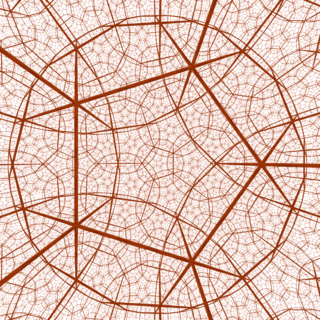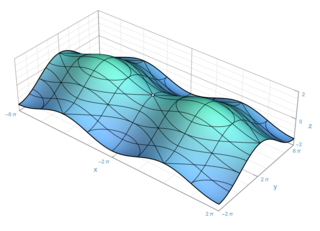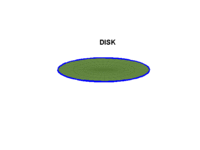
In topology and mathematics in general, the boundary of a subset S of a topological space X is the set of points which can be approached both from S and from the outside of S. More precisely, it is the set of points in the closure of S not belonging to the interior of S. An element of the boundary of S is called a boundary point of S. The term boundary operation refers to finding or taking the boundary of a set. Notations used for boundary of a set S include bd(S), fr(S), and ∂S. Some authors use the term frontier instead of boundary in an attempt to avoid confusion with the concept of boundary used in algebraic topology and manifold theory. However, frontier sometimes refers to a different set, which is the set of boundary points which are not actually in the set ; that is, S \ S known alternatively as the residue of S. Other authors use the term boundary for those points that are in S but not in its interior.
In mathematics, homology is a general way of associating a sequence of algebraic objects such as abelian groups or modules to other mathematical objects such as topological spaces. Homology groups were originally defined in algebraic topology. Similar constructions are available in a wide variety of other contexts, such as abstract algebra, groups, Lie algebras, Galois theory, and algebraic geometry.

In mathematics, a projective space can be thought of as the set of lines through the origin of a vector space V. The cases when V = R2 and V = R3 are the real projective line and the real projective plane, respectively, where R denotes the field of real numbers, R2 denotes ordered pairs of real numbers, and R3 denotes ordered triplets of real numbers.
In the mathematical disciplines of topology, geometry, and geometric group theory, an orbifold is a generalization of a manifold. It is a topological space with an orbifold structure.
In topology, the long line is a topological space somewhat similar to the real line, but in a certain way "longer". It behaves locally just like the real line, but has different large-scale properties. Therefore, it serves as one of the basic counterexamples of topology. Intuitively, the usual real-number line consists of a countable number of line segments [0, 1) laid end-to-end, whereas the long line is constructed from an uncountable number of such segments.
In mathematics, a generalized flag variety is a homogeneous space whose points are flags in a finite-dimensional vector space V over a field F. When F is the real or complex numbers, a generalized flag variety is a smooth or complex manifold, called a real or complexflag manifold. Flag varieties are naturally projective varieties.

In mathematics, the real projective plane is an example of a compact non-orientable two-dimensional manifold; in other words, a one-sided surface. It cannot be embedded in standard three-dimensional space without intersecting itself. It has basic applications to geometry, since the common construction of the real projective plane is as the space of lines in R3 passing through the origin.

In mathematics, specifically in topology, the operation of connected sum is a geometric modification on manifolds. Its effect is to join two given manifolds together near a chosen point on each. This construction plays a key role in the classification of closed surfaces.

In mathematics, low-dimensional topology is the branch of topology that studies manifolds, or more generally topological spaces, of four or fewer dimensions. Representative topics are the structure theory of 3-manifolds and 4-manifolds, knot theory, and braid groups. It can be regarded as a part of geometric topology. It may also be used to refer to the study of topological spaces of dimension 1, though this is more typically considered part of continuum theory.
In mathematics, more precisely in topology and differential geometry, a hyperbolic 3–manifold is a manifold of dimension 3 equipped with a hyperbolic metric, that is a Riemannian metric which has all its sectional curvatures equal to -1. It is generally required that this metric be also complete: in this case the manifold can be realised as a quotient of the 3-dimensional hyperbolic space by a discrete group of isometries.
In mathematics, an adjunction space is a common construction in topology where one topological space is attached or "glued" onto another. Specifically, let X and Y be topological spaces with A a subspace of Y. Let f : A → X be a continuous map. One forms the adjunction space X ∪fY by taking the disjoint union of X and Y and identifying y with f(y) for all y in A. Formally,
In mathematics, a branched manifold is a generalization of a differentiable manifold which may have singularities of very restricted type and admits a well-defined tangent space at each point. A branched n-manifold is covered by n-dimensional "coordinate charts", each of which involves one or several "branches" homeomorphically projecting into the same differentiable n-disk in Rn. Branched manifolds first appeared in the dynamical systems theory, in connection with one-dimensional hyperbolic attractors constructed by Smale and were formalized by R. F. Williams in a series of papers on expanding attractors. Special cases of low dimensions are known as train tracks and branched surfaces and play prominent role in the geometry of three-manifolds after Thurston.

In mathematics, a hyperbolic manifold is a space where every point looks locally like hyperbolic space of some dimension. They are especially studied in dimensions 2 and 3, where they are called hyperbolic surfaces and hyperbolic 3-manifolds, respectively. In these dimensions, they are important because most manifolds can be made into a hyperbolic manifold by a homeomorphism. This is a consequence of the uniformization theorem for surfaces and the geometrization theorem for 3-manifolds proved by Perelman.

In mathematics, a manifold is a topological space that locally resembles Euclidean space near each point. More precisely, each point of an n-dimensional manifold has a neighbourhood that is homeomorphic to the Euclidean space of dimension n. In this more precise terminology, a manifold is referred to as an n-manifold.
In topology, a branch of mathematics, a topological manifold is a topological space which locally resembles real n-dimensional space in a sense defined below. Topological manifolds form an important class of topological spaces with applications throughout mathematics. All manifolds are topological manifolds by definition, but many manifolds may be equipped with additional structure. When the phrase "topological manifold" is used, it is usually done to emphasize that the manifold does not have any additional structure, or that only the "underlying" topological manifold is being considered. Every manifold has an "underlying" topological manifold, gotten by simply "forgetting" any additional structure the manifold has.
In mathematics, algebraic spaces form a generalization of the schemes of algebraic geometry, introduced by Artin for use in deformation theory. Intuitively, schemes are given by gluing together affine schemes using the Zariski topology, while algebraic spaces are given by gluing together affine schemes using the finer étale topology. Alternatively one can think of schemes as being locally isomorphic to affine schemes in the Zariski topology, while algebraic spaces are locally isomorphic to affine schemes in the étale topology.
In mathematics, specifically in symplectic geometry, the symplectic cut is a geometric modification on symplectic manifolds. Its effect is to decompose a given manifold into two pieces. There is an inverse operation, the symplectic sum, that glues two manifolds together into one. The symplectic cut can also be viewed as a generalization of symplectic blow up. The cut was introduced in 1995 by Eugene Lerman, who used it to study the symplectic quotient and other operations on manifolds.
In topology, a branch of mathematics, a topologically stratified space is a space X that has been decomposed into pieces called strata; these strata are topological manifolds and are required to fit together in a certain way. Topologically stratified spaces provide a purely topological setting for the study of singularities analogous to the more differential-geometric theory of Whitney. They were introduced by René Thom, who showed that every Whitney stratified space was also a topologically stratified space, with the same strata. Another proof was given by John Mather in 1970, inspired by Thom's proof.














